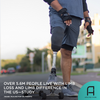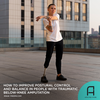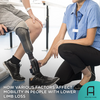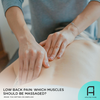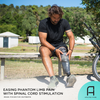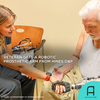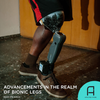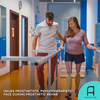Getting Your First Prosthetic Leg? Read This First
Prosthetic legs mimic the function and, in some cases, the appearance of a biological limb. It generally helps those with lower-limb amputations to walk and move around independently and more efficiently. If you have a lower-limb amputation or plan to get an elective amputation soon, you're probably thinking about getting a prosthetic leg. But before you do, here are some things you need to consider and discuss with your healthcare team.

Not everyone is a good candidate for a prosthetic leg
When discussing with your physician the pros and cons of getting a prosthetic leg, you might want to answer the following questions:
-
What are your movement goals?
-
What activities do you want to go back to after amputation?
-
What was your activity level before the surgery?
-
How much pain are you experiencing?
-
Is there adequate soft tissue to cushion the remaining bone in your residual limb?
-
Is your sound side leg healthy?
-
What is your amputation level?
The reason for amputation is also another deciding factor, as it may affect the health of the residual limb. Your physician will also consider your lifestyle and overall physical health. For example, people who led a sedentary lifestyle and lost their leg due to diabetes will find prosthesis use more challenging than those who have an active lifestyle and lost a leg in a car accident.
Remember that when it comes to prosthesis use, each person is unique. This is why you need to work closely with your doctor when deciding whether a prosthetic leg will improve your quality of life or not.
Prosthetic legs are not one-size-fits-all
A prosthetic leg is composed of different components that work together. The decision on what type of component to get depends on your unique needs.
The prosthetic leg itself may or may not feature functional joints, depending on the location of the amputation. The prosthetic socket is an exact mold of your residual limb as it needs to fit snugly over your limb. This component attaches the prosthesis to your body.
You will also need another component to keep your prosthetic leg suspended—the suspension system. Depending on your needs, you may choose sleeve suction, distal locking through lanyard or pin, and vacuum suspension or suction.
There are numerous options for each component mentioned above, each with its pros and cons. Therefore, you need to work closely with your prosthetist to get the correct component type and fit.
Rehabilitation is an ongoing process
Even when you've already decided to get a specific leg, you still need rehabilitation to strengthen your legs, arms, and cardiovascular system. This is important because walking with a prosthetic leg will require twice as much energy.
During your initial rehabilitation, expect to work closely with physical and occupational therapists as well as rehabilitation physicians to develop a plan based on your goals. The focus of your personalized treatment plan is to keep your leg healthy and in good shape. Although prosthetic technology continues to advance, nothing can replace or replicate a healthy leg.
Getting used to a prosthetic leg can be challenging
After your initial rehabilitation, you can expect to run into some issues. This is because getting used to a prosthetic limb is challenging. Typical problems may include:
-
Residual limb weakness
-
Changing residual limb shape
If you encounter any of the issues above, consult your prosthetist and rehabilitation team. They can help you manage the symptoms.
Your prosthetic needs may change
It's completely normal to have varying prosthetic needs as you advance in your amputee journey. At some point, you may realize that you aren't as functional as you'd like to be in your prosthetic limb. This change could be due to your residual limb stabilizing, which means you're ready to transition from a temporary prosthesis to one that can last for three to five years. Or perhaps you find yourself moving more or different than what your prosthetic leg was designed for.
Change is normal. But you need to watch out for discomfort, new pain, and lack of stability when standing or walking. Set an appointment with your prosthetist as soon as you notice any or a combination of these signs.
After a thorough evaluation of your gait, alignment, and prosthesis, your prosthetist might recommend some adjustments to your current leg or replacing one of its components. You might also get a prescription for a new prosthetic limb, which typically happens every three or five years.
Prosthetic technology is ever-evolving
The good thing about technology is that it's constantly improving and changing. The same is true for prosthetic technology. Some new developments include microprocessor joints, which feature sensors and computer chips to provide the user with a more natural gait.
If your lifestyle calls for doing various activities, you can get different specialized prosthetic legs. There are legs for running, swimming, and showering; you simply switch legs as needed. Another option is to have your prosthetist modify your everyday prosthetic leg to serve different purposes.
There are many things you need to consider before finally deciding on a particular prosthetic leg or components. It can feel overwhelming; however, keep in mind that you don't have to make the decision alone. Your healthcare team will help you weigh the pros and cons of each option until you can decide on a leg that matches your lifestyle and goals.





























